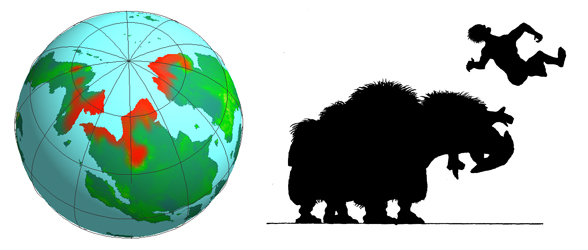
|
Shufflers are large herbivorous hexapods living on Northern tundras. In winter they face heavy snow fall, and in summer they have to deal with soggy marshes. They have developed some interesting adaptations to these challenges. Their broad feet, for instance, allow the shuffler to remain afoot in loose snow as well as in mud. The outgrowth of its jaws forms a kind of shovel, allowing it to find any remaining plants under the snow in winter as well as to uproot marsh plants in summer.
Their unique furry skin covering appears to serve them well in winters only though. In the autumn the skin, containing dermoskeletal cores, grows overlapping folds of thin skin. The sides of the flaps that face one another are covered with hair, while the outside of the flaps remains naked and hairless. In the end of the autumn the flaps are no longer supplied with blood, so they die, but remain attached to the body. When the long winter sets in the animal is equipped with a dry layer of fur acting as the lining in a coat. Unfortunately, many parasites like this cozy environment. The ones living off the shuffler's hairs are called trichophages, while their tiny predators are labelled trichophagophages. Different populations of shufflers can be distinguished by examining differences between their parasite populations. In the spring the dead flaps drop off. During this period shufflers are very irritable, so this is not a good time to sample their parasite populations.
|
|
Shufflers are mostly social animals living in family groups, i.e., that holds for very young, minor male or grown fertile female animals. The few animals that turn into fully grown adult males generally leave such groups and check up on such groups from time to time. Family gropups as well as solitary males are territoria;l, but the two types of territory have rather little in common.
Habitat: tundra
Distribution: Peripolar areas
Mass: 1500 kg
Length: 300 cm
|

|




